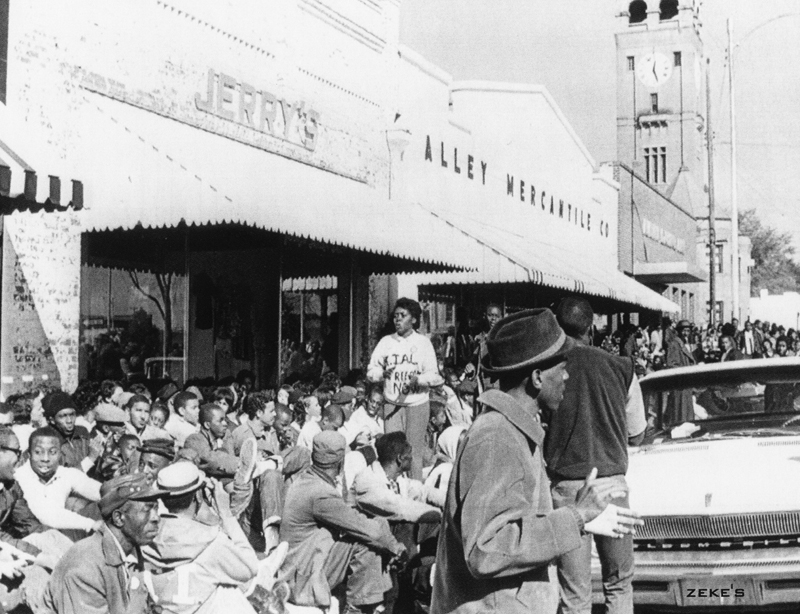January 1966
Murder of Sammy Younge & SNCC’s Statement on Vietnam
The murder of Vietnam Navy veteran Sammy Younge was a major reason for SNCC’s public denunciation of the Vietnam War. On January 3, 1966, the 21-year-old SNCC worker tried to use the “white” bathroom at a service station in his hometown of Tuskegee, Alabama near the town’s only bus station and was shot and killed.
As a committed civil rights activist, Younge was no stranger to violence. Earlier that day, Younge brought 40 people to register to vote at Macon County Courthouse. A registrar pulled out a knife and threatened him. Another registrar threatened Younge’s coworker Jimmy Rogers saying, “I’m tired of fooling around with you, I’m going to spill your guts all over the floor.” The regular violence inflicted on civil rights activists and the Black community as a whole had been and continued to be a major concern of SNCC, which had repeatedly called on the federal government for federal marshal protection for three years. The day of Younge’s murder, the Atlanta SNCC office reported the threats at the courthouse to the FBI and Justice Department, but they refused to send help despite the passage of the Voting Rights Act in 1965.
Two months earlier at the November 1965 staff meeting, prodded by its Atlanta Project, SNCC had decided that it would issue a public statement about Vietnam; but it was of secondary importance to organizing efforts in the South and proceeded slowly. “While we care a great deal about both Vietnam and civil rights,” SNCC worker Dona Richards wrote, “we can’t do anything to help the Vietnam situation, and we can hurt ourselves by trying.” SNCC did not want to risk gains in Black organizing by becoming too heavily involved in anti-war protest. The organization feared further isolation and retaliation. SNCC’s difficulty was “presenting its stand in terms that could unify the staff and appeal to SNCC’s poor Black constituency.”
While the organization did not make a unified public denouncement of the war until Sammy Younge was murdered, many SNCC workers advocated for an end of U.S. involvement in Vietnam. First, SNCC workers with nonviolent and pacifist ideologies viewed Vietnam as a site of U.S. aggression, rather than as a place in need of U.S. intervention for democracy, as the federal government framed it. Bob Moses spoke at the first major anti-war rally organized by SDS and made the connection between the South and Vietnam for activists like Staughton Lynd. Moses said, “The South has got to be a looking glass, not a lightning rod. You’ve got to learn from the South if you’re going to do anything about this country in relation to Vietnam.”
Younge’s murder pushed SNCC to make a public stance on the war, regardless of the political consequences. Three days after Younge’s murder, SNCC’s Executive Committee released a statement on Vietnam according to their “right and responsibility to dissent with United States foreign policy on any issue.” Younge had been murdered, they wrote, “because United States law is not being enforced.” Likewise in the war, the statement read, “Vietnamese are murdered because the United States is pursuing an aggressive policy in violation of international law.” SNCC pointed to the hypocrisy of United States foreign policy on the basis of “democracy,” while cries of protection for those working for democracy in the Black community went ignored. Younge’s murder made the connection between Vietnam and the American South clear.
Setting the stage for SNCC workers to resist induction into the armed forces, the Executive Committee insisted that “work in the civil rights movement…is a valid alternative to the draft. We urge all Americans to seek this alternative, knowing full well that it may cost them their lives – as painfully as in Vietnam.” The draft stole male SNCC organizers from the Movement and put them in the line of fire for a government that didn’t respect their basic rights at home. Shortly after, SNCC created and staffed an anti-draft program.
Sources
Clayborne Carson, In Struggle: SNCC and Black Awakening of the 1960s (Cambridge: Harvard University Press, 1995).
Cheryl Greenberg, ed., A Circle of Trust: Remembering SNCC (New Brunswick, NJ: Rutgers University Press, 1998), 251, 155-160.
Interview with Staughton and Alice Lynd by Joseph Sinsheimer, December 30, 1985, Joseph Sinsheimer Papers, Duke University Libraries.
Michael F. Wright, “Sammy Younge Jr. Memorial Address” Civil Rights Movement Veterans Website.
Statement by the Student Nonviolent Coordinating Committee on the War in Vietnam, January 6, 1966, Lucile Montgomery Papers, 1963-1967, Wisconsin Historical Society.
SNCC Press Release, “Murdered: Sammy Younge,” January 4, 1966, Civil Rights Movement Veterans Website.
“Fire, Praise for SNCC Statement on Vietnam,” The Movement, March 1966, Civil Rights Movement Veterans Website.





